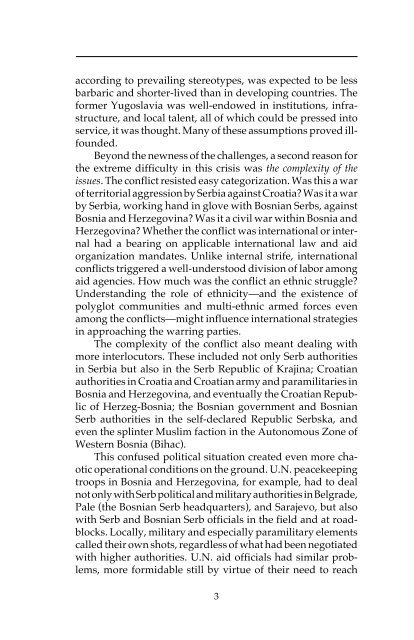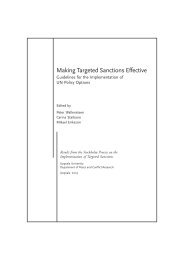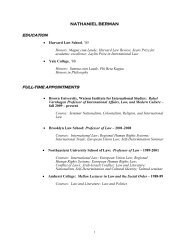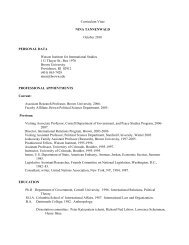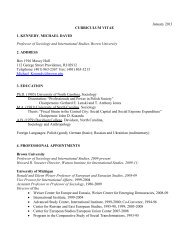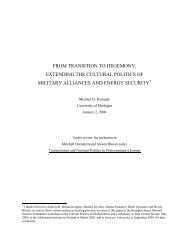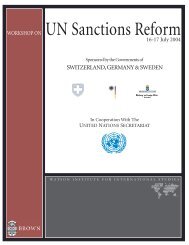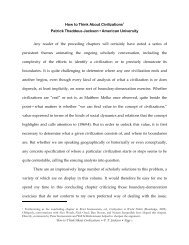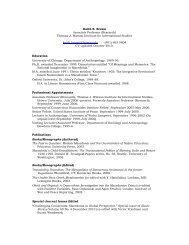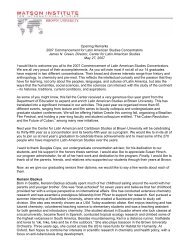op 18 front pages-converted - The Watson Institute for International ...
op 18 front pages-converted - The Watson Institute for International ...
op 18 front pages-converted - The Watson Institute for International ...
Create successful ePaper yourself
Turn your PDF publications into a flip-book with our unique Google optimized e-Paper software.
according to prevailing stereotypes, was expected to be less<br />
barbaric and shorter-lived than in devel<strong>op</strong>ing countries. <strong>The</strong><br />
<strong>for</strong>mer Yugoslavia was well-endowed in institutions, infrastructure,<br />
and local talent, all of which could be pressed into<br />
service, it was thought. Many of these assumptions proved illfounded.<br />
Beyond the newness of the challenges, a second reason <strong>for</strong><br />
the extreme difficulty in this crisis was the complexity of the<br />
issues. <strong>The</strong> conflict resisted easy categorization. Was this a war<br />
of territorial aggression by Serbia against Croatia? Was it a war<br />
by Serbia, working hand in glove with Bosnian Serbs, against<br />
Bosnia and Herzegovina? Was it a civil war within Bosnia and<br />
Herzegovina? Whether the conflict was international or internal<br />
had a bearing on applicable international law and aid<br />
organization mandates. Unlike internal strife, international<br />
conflicts triggered a well-understood division of labor among<br />
aid agencies. How much was the conflict an ethnic struggle?<br />
Understanding the role of ethnicity—and the existence of<br />
polyglot communities and multi-ethnic armed <strong>for</strong>ces even<br />
among the conflicts—might influence international strategies<br />
in approaching the warring parties.<br />
<strong>The</strong> complexity of the conflict also meant dealing with<br />
more interlocutors. <strong>The</strong>se included not only Serb authorities<br />
in Serbia but also in the Serb Republic of Krajina; Croatian<br />
authorities in Croatia and Croatian army and paramilitaries in<br />
Bosnia and Herzegovina, and eventually the Croatian Republic<br />
of Herzeg-Bosnia; the Bosnian government and Bosnian<br />
Serb authorities in the self-declared Republic Serbska, and<br />
even the splinter Muslim faction in the Autonomous Zone of<br />
Western Bosnia (Bihac).<br />
This confused political situation created even more chaotic<br />
<strong>op</strong>erational conditions on the ground. U.N. peacekeeping<br />
tro<strong>op</strong>s in Bosnia and Herzegovina, <strong>for</strong> example, had to deal<br />
not only with Serb political and military authorities in Belgrade,<br />
Pale (the Bosnian Serb headquarters), and Sarajevo, but also<br />
with Serb and Bosnian Serb officials in the field and at roadblocks.<br />
Locally, military and especially paramilitary elements<br />
called their own shots, regardless of what had been negotiated<br />
with higher authorities. U.N. aid officials had similar problems,<br />
more <strong>for</strong>midable still by virtue of their need to reach<br />
3


